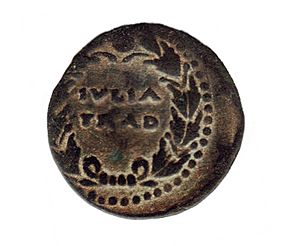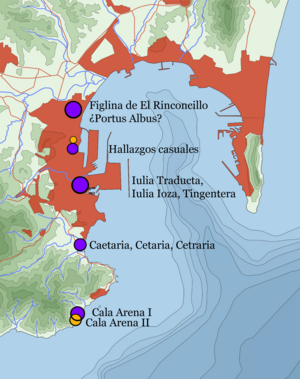Iulia Traducta facts for kids
Iulia Traducta was an ancient Roman city located in what is now Andalusia, Spain. It stood where the modern city of Algeciras is today.
Contents
Where Was Iulia Traducta Located?
For a long time, historians weren't sure exactly where Iulia Traducta was. Some thought it was near Tarifa, another town in Spain. Others, like the ancient writer Pliny, even believed it was in Mauretania (North Africa). Strabo, another ancient writer, called it Iulia Ioza and said it was on the Mediterranean coast of Hispania Baetica (Roman Spain).
However, new discoveries and research in Algeciras have changed what experts think. An old Roman travel guide called the Antonine Itinerary helped a lot. It didn't mention Iulia Traducta in the Bay of Gibraltar area. Instead, it named a place called Portus Albus, which was between two other Roman towns, Carteia and Mellaria.
Another old map, the Ravenna Cosmography, mentioned "Transducta" (which is Iulia Traducta) between Carteia and Caetaria, both near Algeciras Bay. Today, many historians believe that Portus Albus was a port in the northern part of modern Algeciras, while Iulia Traducta was in the older part of the city. It's also possible that Portus Albus was just another name for Iulia Traducta's port.
How Was Iulia Traducta Founded?
Ancient writers like Pliny the Elder and Strabo wrote about Iulia Traducta. Strabo said that between 33 and 25 BC, some people from a North African city called Zilis were moved to the Iberian Peninsula to live in Iulia Traducta. He also mentioned that people from Tingi (modern Tangier) were moved there too. This is why the city was sometimes called Tingentera, meaning "the other Tangier."
The historian Pomponius Mela was born in Tingentera. He wrote that the city was founded after people from Zilis and Tingis moved there. Coins from Tingis even had "Tingis Maior" (Greater Tingis) written on them, suggesting there was a "Lesser Tingis" or "Other Tingis" (Iulia Traducta).
Modern historians believe that the Roman emperor Octavian (later known as Augustus) founded the city. He wanted to create a strong city of his supporters in Betica (Andalusia), an area that had supported his enemy Pompey during the Roman Civil War. So, he moved people from Zilis and Roman soldiers to Iulia Traducta.
What Was the Economy Like?
The people of Iulia Traducta mainly focused on fishing and making salted fish. Archaeologists have found a large fish-processing factory in Algeciras's Old Town. This factory was used from the first century AD until about the fifth or sixth century.
Inside the factory, many grinding stones were found, along with traces of fish. This suggests they ground down fish bones to make fish flour. The salting factory was very large, stretching across much of the Old Town.
Iulia Traducta also had its own mint (a place where coins are made) around 12-10 BC. This shows how important the city's fishing industry was. The coins featured images of Emperor Augustus and his sons, as well as symbols related to the city's economy, like tuna fish. This was part of Augustus's plan to show his power and importance.
People in Iulia Traducta might have also made wine. Many amphorae (large containers for liquids) used for wine have been found. While a bigger pottery complex was in nearby Portus Albus, there were also potteries in Iulia Traducta. These kilns (ovens for firing pottery) were used to make amphorae and date back to the first century AD. This suggests that Iulia Traducta's economy grew, possibly taking over some production from nearby Carteia.
The exact size of Iulia Traducta is not fully known, but it likely covered the Old Town area of Algeciras. The Río de la Miel (Honey River) probably served as a port for fishing boats.
What Happened Later?
The historian Gregory of Tours wrote that Iulia Traducta was where the Vandals (a Germanic tribe) boarded their ships when they invaded North Africa in 429 AD. After this, ancient writings don't mention Iulia Traducta much, which made some people think it was abandoned until the Muslim invasion of Spain in 711 AD.
However, recent archaeological digs in the Old Town have found structures from the Byzantine period (around the sixth century), including a cemetery. They also found remains of amphora production and even a Byzantine chalice (a special cup) near a later Muslim mosque. These discoveries suggest that the city was never completely abandoned. In fact, when the Arab invasion happened, Iulia Traducta was probably the most important town in the Strait of Gibraltar area.
See also
 In Spanish: Iulia Traducta para niños
In Spanish: Iulia Traducta para niños




